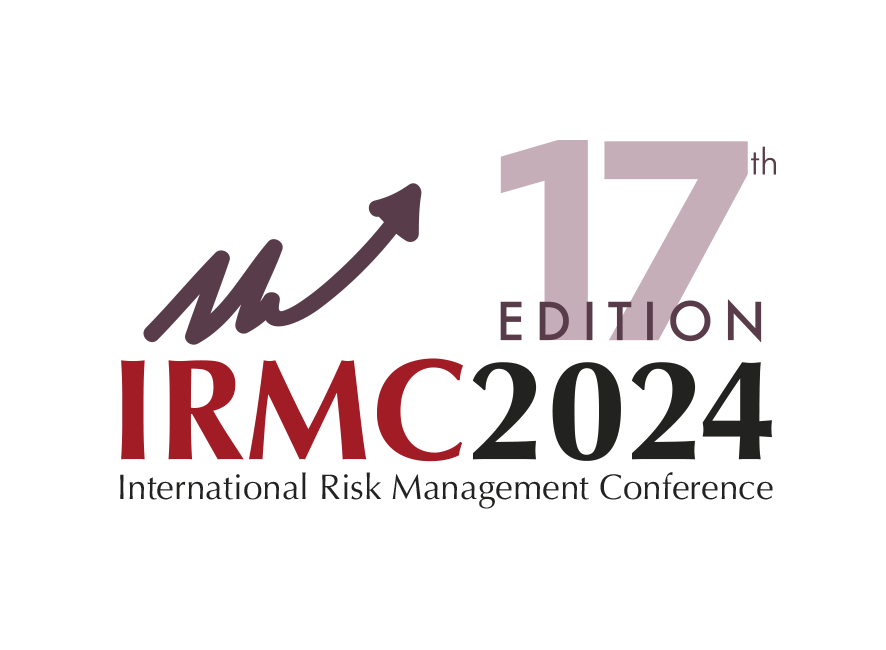
- HOME
- Conference
- About The Conference
- Conference Topics
- Keynotes & Featured Speakers
- Best Paper Awards IRMC2024
- IRMC Best Paper Awards – WINNERS
- Conference Fees
- Paper Submission
- Past Conferences
- Keynotes & Featured Speakers IRMC2023 – Florence, Italy
- Keynotes & Featured Speakers IRMC2022 – Bari, Italy
- Keynotes & Featured Speakers IRMC2021 – Cagliari, Italy
- Keynote & Featured Speakers IRMC2020 – Virtual conference, online
- Keynote & Featured Speakers IRMC2019 – Milan, Italy
- Keynote & Featured Speakers IRMC 2018 – Paris, France
- Keynote & Featured Speakers, IRMC 2017 – Florence, Italy
- Keynote Speakers, IRMC 2016 – Jerusalem, Israel
- Registration
- Organizers
- Travel&Lodging
- Publications
- Conference Program
Conference Topics
International Risk Management ConferenceA special session is dedicated to climate-change risks and resilience of financial
institutions.
Regular Topics
A. Credit risk and portfolio management
B. Liquidity risk after the subprime upheaval
C. Counterparty risk
D. Market and reputational risk
E. Rating failure in the subprime crisis
F. Challenges for risk management
G. Failures in risk management
H. Interest rate and currency markets manipulation, how to fix the system?
I. Bankruptcy prediction and the role of information
J. The role of Market information for Central Banks
A. Strategic risk taking: exploiting upside risks
B. Assets valuation under uncertainty
C. Corporate governance, incentives and risk taking in emerging market
D. Enterprise/Corporate risk management
E. Corporate governance and market relationship
F. Hedging enterprise risk and corporate value
G. Treasury management and liquidity crisis
H. Managing market Imperfections
I. Value maximization in volatile markets
J. Capital structure and credit ratings fundamentals
K. Liquidity shortage and companies credit crunch
L. Risk assessment and value of fast growing firms
A. Banking system and Basel III
B. Deposit insurance
C. Risk based contributions
D. Resolution funds and banks crisis management
E. International institutions, market regulation and supervision
F. Financial stability, systemic risk and contagion risk
G. Measures of financial stability and systemic risk
H. Network analysis and contagion risk
I. The role of central bank for financial stability, within macro prudential supervision and payment system oversight
J. Price stability and financial stability as joint goals of the central bank
K. Microprudential supervision and regulation
L. The triple goal of the central bank; price stability, employment and financial stability
M. Integrated risk management in financial institutions and enterprises
N. Capital and risk taking behavior in financial institutions. Basel III and Solvency II
A. Volatility and GARCH models
B. Regime-switching models
C. Empirical asset pricing
D. Learning in financial markets
E. Predictability in financial markets
F. Forecasting risk
G. Lévy processes
H. Statistical classification and prediction models
I. Multi-decision rules
J. Model averaging and model selection
K. Asset bubbles
L. Ambiguity and other decision rules in finance
A. Sovereign risk assessment methologies
B. Credit risk and macroeconomic variables
C. IAS and IFRS and risk management
D. The risk reporting in the international financial accounting standard
E. Fair value vs. historical cost under the crisis
F. Internal auditing and corporate risk management
G. Accounting measurement and perfomances measurement
H. Sustainable Finance
A. The status of title VII of Dodd-Frank (OTC)? What is the status of the CDS Markets?
B. The effect of the CFTC Swap rules on the participation of financial institutions in the derivatives markets
C. Restructuring the interest rates swap market; from OTC to Swap Execution Facilities (SEF)
D. The costs and benefits of the derivatives markets; Will the newly regulated structure enhance the safety of the financial system?
A. Executive compensation and incentives. Responses to the crisis
B. An optimal system for executive compensation
This session invites submissions related to the impact of the pandemic on sovereign institutions, financial institutions and financial markets. Broadly, the extended abstracts should be focused on the impact of the crisis on all asset classes, derivatives markets, central banks, financial intermediaries and other financial system related entities. Detailed topics are among the following:
Central Bank measures and liquidity “bazooka-effect” during COVID-19 Pandemic; Liquidity risk and Market liquidity in equity and debt markets, exchange-traded and OTC securities and derivatives; Information about coronavirus pandemic and asset prices determination: the impact of financial information on assets price; High-frequency data analysis and anomaly detection in stocks, oil, commodities, repos and potential; The impact of government policies implemented before or during the crisis on financial markets and institutions; Procyclical feedback of central counterparty margin requirements, regulatory capital requirements, and bank risk-management practices; Borrower runs on bank lines of credit; Asset management performance during the pandemic: leveraged ETFs, and crowded trades. Lending and performance of financial institutions during the crisis.